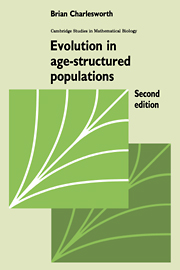Book contents
- Frontmatter
- Contents
- Preface
- Preface to the second edition
- 1 Models of age-structured populations
- 2 The genetics of populations without selection
- 3 Selection: construction of a model and the properties of equilibrium populations
- 4 Selection: dynamic aspects
- 5 The evolution of life-histories
- Appendix 1 Generating functions and their properties
- Appendix 2 Asymptotic values of ρpi and 2ρi
- References
- Author index
- Subject index
3 - Selection: construction of a model and the properties of equilibrium populations
Published online by Cambridge University Press: 18 December 2009
- Frontmatter
- Contents
- Preface
- Preface to the second edition
- 1 Models of age-structured populations
- 2 The genetics of populations without selection
- 3 Selection: construction of a model and the properties of equilibrium populations
- 4 Selection: dynamic aspects
- 5 The evolution of life-histories
- Appendix 1 Generating functions and their properties
- Appendix 2 Asymptotic values of ρpi and 2ρi
- References
- Author index
- Subject index
Summary
Introduction
The problem of the theory of natural selection in age-structured populations was first considered quite early in the history of population genetics, by Haldane (1927a) and Norton (1928). Until comparatively recently, there was little interest in adding to the important contributions of these authors, apart from the isolated paper of Haldane (1962). This is probably largely due to the introduction by Fisher (1930) of his well-known ‘Malthusian parameter’ method of dealing with selection in continuous-time populations, which apparently provided a simple and elegant asnwer to the problem, and has since been extensively employed in population genetics (Crow and Kimura, 1970). This method assumes that fixed per capita birth-rates and death-rates can be assigned to each genotype, analogous to the rates defined in section 1.3.2 for a genetically homogeneous population in stable age-distribution. The Malthusian parameter for a genotype is the difference between these two quantities, and is used in differential equations for gene frequency change in much the same way that the standard discrete-generation fitness measure of Wright and Haldane is used in difference equations. But as pointed out by several authors (Moran, 1962; Charlesworth, 1970; Pollak and Kempthorne, 1970, 1971), an individual genotype cannot have a fixed per capita birth-rate and death-rate when the genotypic composition of a population is changing under natural selection, resulting in a continual disturbance of the population's demographic structure.
- Type
- Chapter
- Information
- Evolution in Age-Structured Populations , pp. 105 - 135Publisher: Cambridge University PressPrint publication year: 1994



